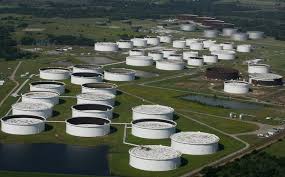
Even a report of available storage space at the Cushing hub couldn’t keep U.S. oil prices from falling Wednesday.
West Texas Intermediate crude was off 2% for June delivery on the New York Mercantile Exchange, falling by 49 cents to settle at $25.29 a barrel. It had been briefly higher earlier in the day following the release of supply data from the Energy Information Administration.
The EIA data also showed crude stocks at the Cushing, Okla. storage hub declined by 3 million barrels last week to 62.4 million barrels. Working storage capacity at Cushing stands at around 76 million barrels.
The international benchmark, Brent crude fell 79 cents or 2.6% on July futures and ended the day at $29.19 a barrel on ICE Futures Europe.
MarketWatch reported the June futures at Cushing failed to find support even after U.S. government data showed an unexpected weekly decline in domestic crude supplies, along with a fall in stocks at a key storage hub in Cushing, Okla.
Dwindling storage capacity in Cushing was blamed in large part for driving the expiring May WTI contract into negative territory for the first time in history last month. The COVID-19 pandemic has destroyed demand for crude, contributing to a global glut.
“Any further upside [for prices] will be rather tepid from here,” said Tariq Zahir, managing member at Tyche Capital Advisors.
“As we have seen a good amount of states opening back up, demand for gasoline should easily continue to get better—especially since we are coming from such a demand destruction here in the U.S.” he told MarketWatch. “However, air travel worldwide…is a long way from coming back.”
Oil can “definitely go higher a few dollars in the next few days, but we feel it will be short lived,” he said. “With space becoming available in Cushing, and with prices going higher” recent pledges by certain countries to cut production may not see full compliance.
The Energy Information Administration reported Wednesday that U.S. crude inventories fell by 700,000 barrels for the week ended May 8. That marked the first weekly decline in 16 weeks and defied a forecast by analysts polled by S&P Global Platts for an average increase of 4.8 million barrels. The American Petroleum Institute on Tuesday reported a climb of 7.6 million barrels.
The EIA report was “bullish, but the mood is bearish,” Phil Flynn, senior market analyst at The Price Futures Group, told MarketWatch. “The risk-off environment in the stock market is having traders overlook the green shoots” in the report.
“One of the bigger eye opening numbers was the draw we saw in Cushing and a rather large one,” Zahir told MarketWatch. “Overall, not a total shock on our end seeing these numbers” coupled along with the announcement from Saudi Arabia that it will voluntarily cut of another one million barrels from its production starting in June, in addition to reductions under the agreement between the Organization of the Petroleum Exporting Countries and its allies, collectively known as OPEC+.
Total U.S. oil production fell by 300,000 barrels a day to 11.6 million barrels a day, the EIA data showed.
In a monthly report Tuesday, the EIA forecast U.S. crude production at an average 11.7 million barrels a day this year. That would be down 500,000 barrels a day from 2019, it said.
Gasoline supply fell by 3.5 million barrels, while distillate stockpiles rose 3.5 million barrels, according to Wednesday’s EIA data. The S&P Global Platts survey had shown expectations for a supply decline of 2.5 million barrels for gasoline, while distillate stocks were forecast at 4.1 million barrels higher.
On Nymex, June gasoline RBM20, -7.49% dropped 7.2% to 85.27 cents a gallon, while June heating oil HOM20, -0.10% fell 0.8% to 83.14 cents a gallon.
June natural gas NGM20, -4.47% settled at $1.616 per million British thermal units, down 6.1%.
Meanwhile, in a monthly report released Wednesday, the Organization of the Petroleum Exporting Countries further cut its forecast for global oil demand in 2020, but also forecast a drop in supply as low prices take a toll on production around the world.
OPEC reduced its forecast for 2020 crude demand by 2.23 million barrels a day from its April projection. OPEC now expects oil demand to fall by 9.07 million barrels a day this year.
The head of the International Energy Agency warned demand for the commodity could remain below pre-coronavirus levels for another year, according to a Bloomberg News report Wednesday.
Source: Market Watch





